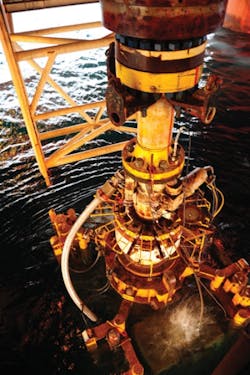BP PLC Chief Executive Tony Hayward and federal workplace safety officials separately marked the 5th anniversary of the fire and explosions that killed 15 people and injured 180 others at the company's Texas City, Tex., refinery on Mar. 23, 2005.
Workers at the 455,790-b/d BP Products North America Inc. plant observed a moment of silence at 1:20 p.m. CDT—the time the accident occurred 5 years earlier. "That tragic accident has changed, in a profound and fundamental way, our approach to safety and operations integrity," Hayward said as he began a speech at the Peterson Institute for International Economics in Washington, DC. "Providing a safe working environment is a paramount responsibility, and our first and foremost priority."
The US Chemical Safety Board said in a 2007 report that cost-cutting by the BP division led to malfunctioning equipment and overworked and undertrained employees, and that the US Occupational Safety and Health Administration failed in its investigative responsibilities. OSHA proposed a record $87 million fine against the company on Oct. 30, 2009. BPNA formally contested the citations.
"As we've seen from [OSHA's] recent enforcement actions, BP still has a long way to go to ensure the safety of its employees and those of the contractors who work at its refineries," US Secretary of Labor Hilda L. Solis said on Mar. 23.
Solis said she hoped the refining and petrochemical industry was reminded that day to examine and improve safety systems and its corporate safety culture. "These measures should include looking at how their organizations address safety issues, the extent of management commitment and working participation in improving safety systems, the adequacy of training and maintenance, and the use of leading indicators like close calls to gauge the safety of their facilities," she said.
Recommit to safety
CSB Chairman John B. Bresland also urged refiners "to take a moment today and think about that tragic loss of life and the severity of so many injuries which continue to afflict workers 5 years later." He said it also would be appropriate for BP to recommit to safety in a way that builds on steps it took following the Texas City blasts and fire.
Bresland said CSB's investigation following the accident was the most comprehensive and detailed inquiry in the board's history, and that it found organizational and safety deficiencies at all levels of BP. "Our investigation team turned up extensive evidence showing a catastrophe waiting to happen," he said.
Cost-cutting had affected safety programs and critical maintenance, production pressures had resulted in costly mistakes by workers fatigued from long hours on duty, and internal audits and safety studies brought problems to the attention of BP's board, which did not sufficiently respond, Bresland said. "Yet the company was proud of its record on personnel safety," CSB's chairman said.
BP immediately launched an internal investigation following the accident, including technical and safety experts from across the company, employees and supervisors from the refinery, and outside experts to model the explosion and test key components, often in consultation with CSB investigators. An interim report emerged 2 months later and a final report was issued in December 2005.
John Mogford, the BP's senior group vice-president for safety and operations who led the internal investigation, in an April 2006 speech, said, "The CSB has been critical of our operations at Texas City and, as some of you know, there are areas where we disagree—for example, over issues where there is limited evidence."
'Generally consistent'
"It shouldn't be a surprise that there are differing interpretations of what happened, Mogford said, adding, "After an incident of this magnitude, it's probably inevitable. What's more important is that our findings are generally consistent. BP immediately committed $1 billion over 5 years to upgrade and improve the plant, including installation of modern process control systems on major units, eliminating the use of blow down stacks in light service, and improving workforce training "which, frankly, has been inadequate," Mogford said.
The accident also had a profound impact on other refinery and petrochemical plant owners and operators, according to Bob Greco, downstream operations group director at the American Petroleum Institute. "It spurred a wide range of actions intended to prevent this type of tragedy from ever happening again," he told OGJ on Mar. 24. Individual companies reviewed their own safety processes and procedures and identified individual improvements such as holding safety drills more frequently and identifying responsibilities more specifically, he said.
API, working with its members, also released a series of new and revised standards in response to the accident, Greco said. In 2007, it issued a standard regarding the safe siting of portable buildings, and in 2008, it revised its standard on pressure-relieving systems. "Both of those were in response to CSB recommendations to API," Greco said.
"Late last year, we finalized a revision to our standard for the siting of permanent buildings," Greco said, adding, "We are close to finalizing two new standards, one on process safety performance indicators and another on fatigue risk-management systems. Both also were responses to recommendations from the CSB. They should be out next month."
Solis said OSHA is entering the final stages of a comprehensive National Emphasis Program (NEP) that has examined most US refineries and which, where necessary, initiated action to compel elimination of hazards. The agency also initiated an NEP for the chemical industry "with the ultimate goal of preventing catastrophic incidents that can injure and kill employees and affect entire communities," she said.
More Oil & Gas Journal Current Issue Articles
More Oil & Gas Journal Archives Issue Articles
View Oil and Gas Articles on PennEnergy.com



